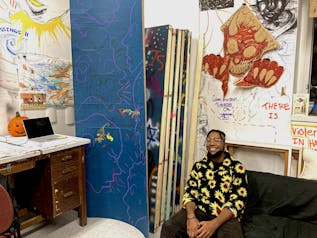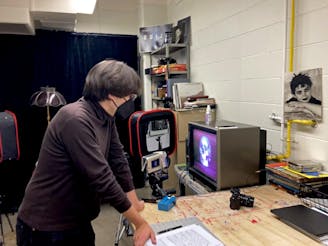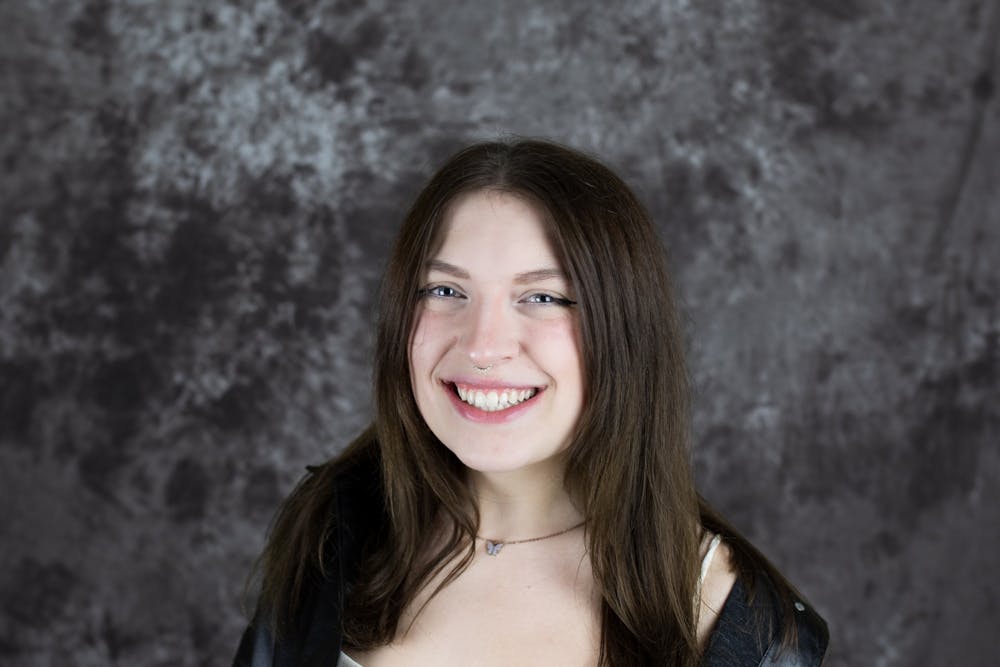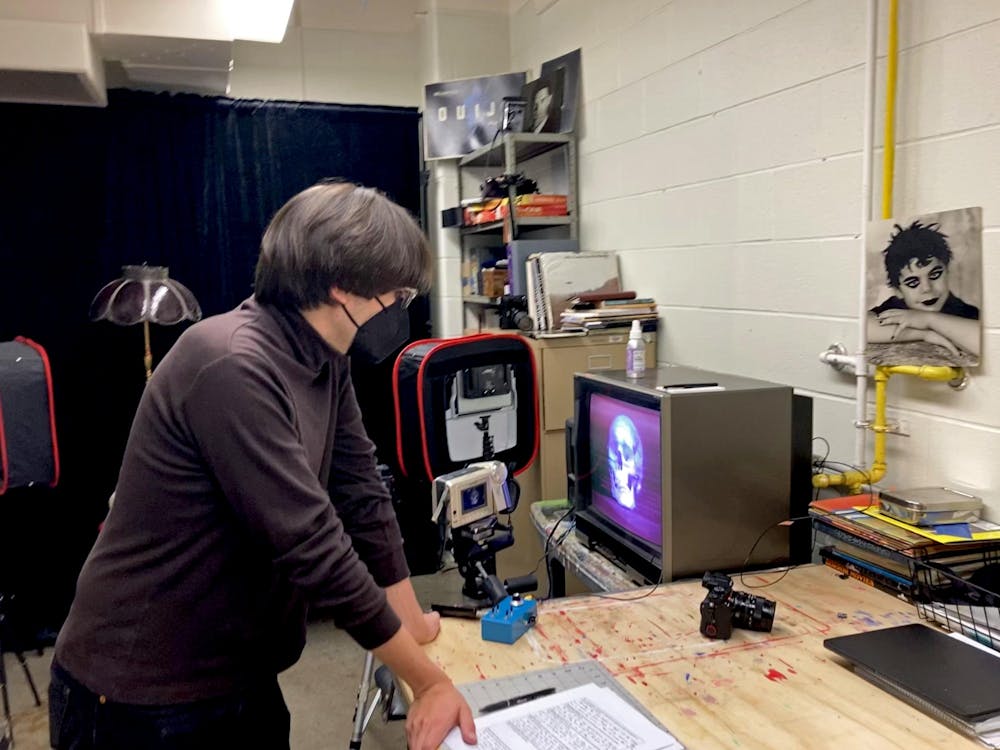From the basement to the ceiling, the CFA teems with art.
Bustling visitors are greeted by a wonderland of uninhibited creativity — from live jazz music to macabre ghost photography to student-produced films on weathermen.
Projects are in development, dances are being rehearsed — it’s a decidedly unfinished view of art in progress.

This look into UB’s own evolving world of craftsmanship is the result of Art in the Open, a free event which took place on Oct. 28 that opens studios, classrooms and stages to the public. The event, which was held for the first time in 2019, aims to showcase the current — and often incomplete — work of artists in mediums ranging from chainmail sculpture to choir singing.
In visiting a space that blurs the lines between polished exhibits and the authentic art-making process, visitors and artists alike found Art in the Open promoted a more personal engagement with art than typically allowed in formal settings, like museums.
Jonathan Golove, director of Open! Strings Ensemble and Music Department chair, says that performing amid a crowd, without the usual stage, helped foster an environment most suitable to enjoying music.
“It brings it back to what for many of us is the ideal condition of playing music, which is in your living room with a few people listening,” Golove told The Spectrum. “It has that again, instead of the formality of a concert hall. It has that intimate, among friends quality and that’s a kind of ideal for music.”
Golove is not alone in his feeling that Art in the Open creates an optimal space for engaging with art.
Nicole Chochrek, a graduate fine arts student, says the event provided an opportunity to present her studio and creative process, something that is typically more private, to the public.
“It’s always really wonderful to be able to share and get feedback,” Chochrek said. “Just to see how people connect with the work [was really cool] because a lot of the time we make it in closed doors.”
The artists may have benefited from the open dialogue, but visitors also found that the ability to step into an artist’s workspace augmented their experience with the work at hand.
“It’s really cool because you’re not only seeing the work displayed on the walls, as it should be, but you’re seeing it within its field of creation, which is really interesting,” Cassandra Cristimilios, a junior studio art major, said. “And that’s something that’s super unlike any other experience.”
As visitors engaged with art in its place of creation, some artists felt that the informality and intimacy of the experience made their work more accessible to the general public.
“It demystifies what art is,” Joan Nobile, a media study adjunct instructor and MFA candidate, said. “I think that helps people go, ‘You know, art is a sort of mysterious thing, but I can’t understand it,’ to, ‘Oh, this is actually pretty cool.’”
In deconstructing the mystery behind art, Art in the Open also gave visitors and artists a chance to experience the behind-the-scenes technological work that goes into the performing arts.
“Usually I’m just onstage and I’m dancing and focused on that,” Kelsey Wegman, the student assistant to Emerging Choreographers Showcase’s director and a senior dance major, said. “I don’t get to really watch how it all builds, so I think it’s cool that outsiders can also do the same thing and see like, ‘Oh wow, that’s how the lighting kind of gets up!’”

As the barriers between audience and performance dissolved, artists also expressed that Art in the Open helped bring together the various disciplines found in the CFA.
Although unable to explore the event beyond the Mainstage Theatre, where ECS held their dance rehearsal, Wegman still felt the presence of the arts coming together as music from the atrium trickled into the auditorium.
“We’d hear clapping and we’d make jokes, hearing different things going on,” Wegman said. “Like, if it was a serious part of the dance and all of a sudden there’s this loud singing in the background.”
In bringing together all types of artists, some participants felt that Art in the Open was the ideal art exhibit.
“[Art in the Open] is kind of the maximum point of that where there’s something really going on everywhere,” Golove said. “It is chock full of that. It wouldn’t be like that everyday, but that’s the kind of model.”
For many people, Art in the Open represented the first opportunity to take a behind-the-scenes peek into the art world in person since the beginning of the COVID-19 pandemic.
In hosting such a large-scale and public event, some expressed feelings of anxiety.
“It’s been tough not just for me, but for everybody,” Nobile said. “You’re going from this very scary feeling of, ‘I don’t want to be near people,’ to all of a sudden opening up the entire atrium to not just everyone here, but the public as well.”
Despite this trepidation in returning to normalcy, many of the event’s participants expressed a prevailing sense of appreciation for experiencing art in person again.
For some artists who opened their studios to the public, this return to an in-person event gave them the opportunity to rethink their perception of their own art based on feedback and commentary from visitors.
“Being able to have conversations like this places a kind of normalcy,” Tayron Lopez, a graduate fine arts student, said. “It allows me to get away from myself. It brings fulfillment and affirmation to [my art].”
For others, the mere premise of having in-person visitors again encouraged them to see their studio less as a place of work and more as a place of creation.
“It's weird, in order to make [my studio] feel like a home that’s worth presenting, it becomes something that I actually want to spend time in,” Robert George, a graduate fine arts student, said regarding the setup of his studio.
As artists navigated the return to public events, some said that Art in the Open served as a reminder that art is still best experienced in person.
“You can see the passion and the hard work or when somebody is dancing, you see their entire body and this fluid, wonderful movement,” Nobile said. “Or when you look at a painting and you can pay attention to the textures and the strokes used and the emotion felt in the painting. You get all of this wonderful plethora of expression and creativity and emotion and thought and it’s just so fantastic to see. I think Art in the Open is a wonderful venue for that and it’s as good for the public as it is for the artists themselves.”
Kara Anderson is the asst. arts editor and can be reached at kara.anderson@ubspectrum.com
Paolo Blanchi is the creative director and can be reached at paul.blanchi@ubspectrum.com and on Twitter at @paulblanchi21

Kara Anderson is a senior arts editor at The Spectrum. She is an English and Spanish double major and is pursuing a certificate in creative writing. She enjoys baking chocolate chip cookies, procrastinating with solitaire and binging reality TV on the weekends.





